“It is not the literal past that rules us. It is images of the past.”
—George Steiner1
The installation Studio Visit (2012) by the Filipino artist Maria Taniguchi was composed a series of 24 plywood tablets on which the artist had etched notes, scribbles and sketches or diagrams from her diary of 2009-2010. The tablets included words and images that had been then crossed out, indicating what had been erased and rewritten. The work reveals the process of iteration, erasure and revision with all stages documented, if not shown, as part of the finished work. Crossed out, painted over, a trace nevertheless, of what had been marked, remained. The following year in 2013, the fellow Filipino artist Nilo Ilarde produced Erased Eraser, which was the result of rubbing 15 different erasers until their form disappeared. The residue was then “cast using resin, into the erasers’ original form.
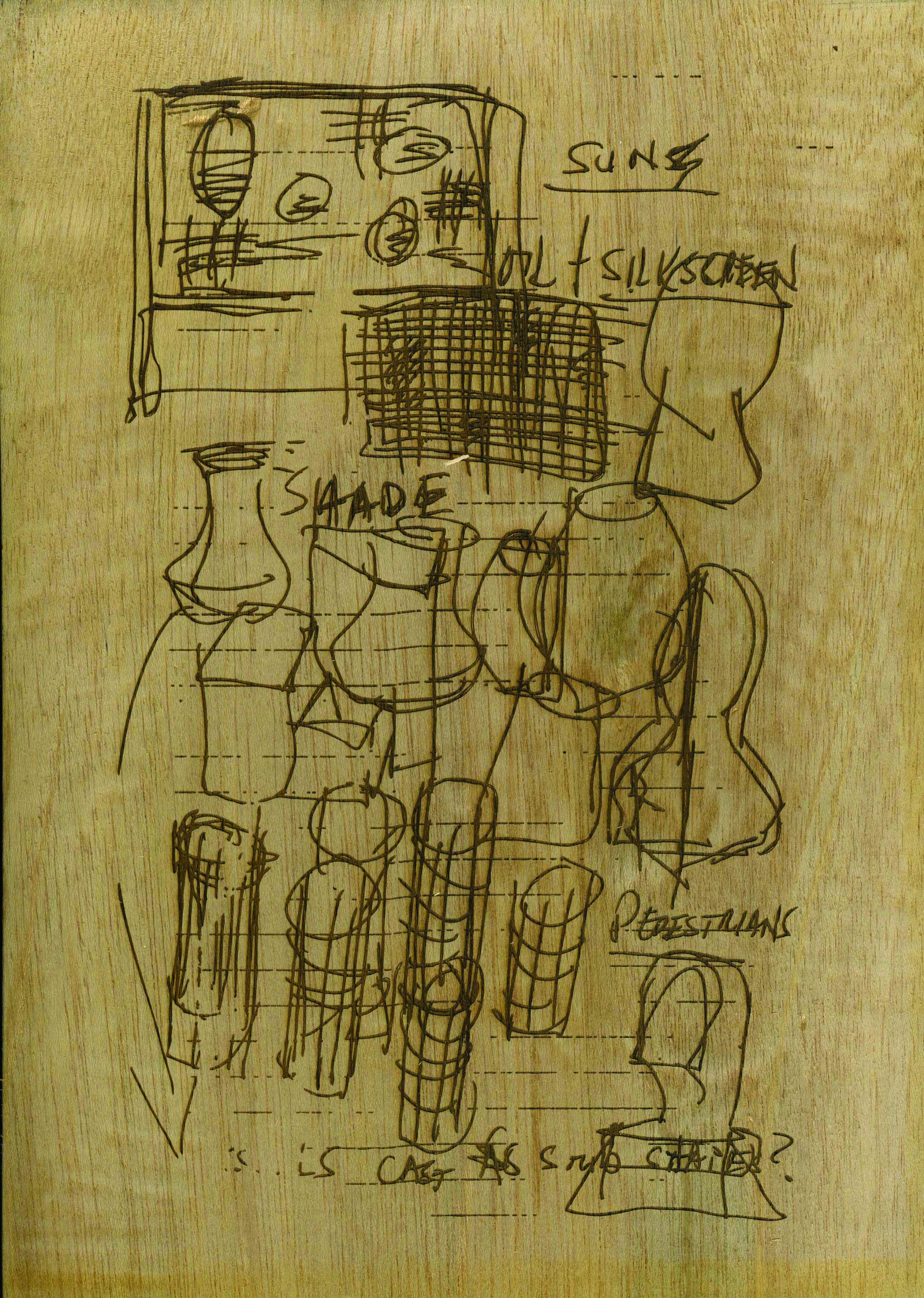
Maria Taniguchi
Studio Visit
2012
Laser etching on 24 plywood tablets
Dimensions variable
Photo: Silverlens and the Artist
Merewether, Charles. The Fact Remains. In ISSUE 08: Erase. Singapore: LASALLE College of the the Arts, 2019. pp. 47-57.
These two conceptual works raised the method of erasure as part of an artistic process of creating a new art work. In the following remarks, I wish to follow some historical use of erasure beginning with its modern origin with the discovery of rubber, the material first used for the eraser.
Rubber was an integral part of Asian and Latin American colonial economies, especially in countries such as Malaysia, Sri Lanka (Ceylon), Java or Brazil and Nicaragua. Ilya Ehrenburg’s novel traces this development of rubber during the colonial period.2 His novel The Life of the Automobile, published in 1929, is a story of rubber taken from Malaysia to Europe. It tells of a Frenchman who, on driving his new Citroën, experiences the modern thrill of speed, only to then crash his car in a fatal accident. The book jumps from the brutal North American intervention in Nicaragua seeking to secure rubber supplies for tire factories to wild gambling on Citroën in the Paris stock exchange. Ehrenburg writes:
There are no people at the stock exchange…There are only names and numbers, the lofty and tender names of three thousand securities. Royal Dutch, Rio Tinto, Malakka – oil, copper, rubber; names and numbers; numbers swarm, whirl, buzz, like locusts. Numbers decide everything here.3
The discovery of latex from rubber trees led to the invention of the rubber eraser in the 18th and 19th centuries. And, the invention of the rubber eraser changed the process of writing and reading of history in small but critical ways. This was long before fake news became a recurrent component of everyday life.
With the rubber eraser, someone could delete what they had written: a word, a text and as a consequence, the history accounted for in written books. That is, an event that had happened could be erased in the re-writing of history. Nevertheless, sometimes, there were and are conflicting accounts in what has been documented in image or written form or recalled verbally. This raised the issue of competing evidence and what might be claimed as more substantive in its claim to truthfulness. And yet, as I wish to show in this essay, there is an indelible difference between an event and its account whether in writing, image or another form and how the event might be ‘re’-presented.
In the editorial proposal brief for this ISSUE 08: Erase, a somewhat benign interpretation of the topic is used to characterise the use of erasure in the visual arts. In the introduction for this ISSUE 08: Erase, the editor writes:
In visual art, to erase is a method of consistently bringing to light a new perspective or dimension. In art, distancing oneself from the need to erase (to forget), is pertinent in unleashing ways of imagining the world and bringing to the forefront ideas deeply buried in the human conscience.4
For sure, erasure can open the way to new spaces in imagining the world. However, forgetting as a form of erasure, is also a necessary part of how memory works, enabling the distancing of oneself from remembered painful or unhappy incidents and, in the process, opening up new spaces for new experiences. In such a way, it can allow for a new perspective on history or events that have occurred. But, equally, the ‘conscious’ erasure of what has actually passed is another dimension of this process of forgetting. This does not happen as a natural process of memory but is the calculated, if not wilful, act of eradicating something. It is not simply to conceal or obscure but to eradicate it as if it never happened.
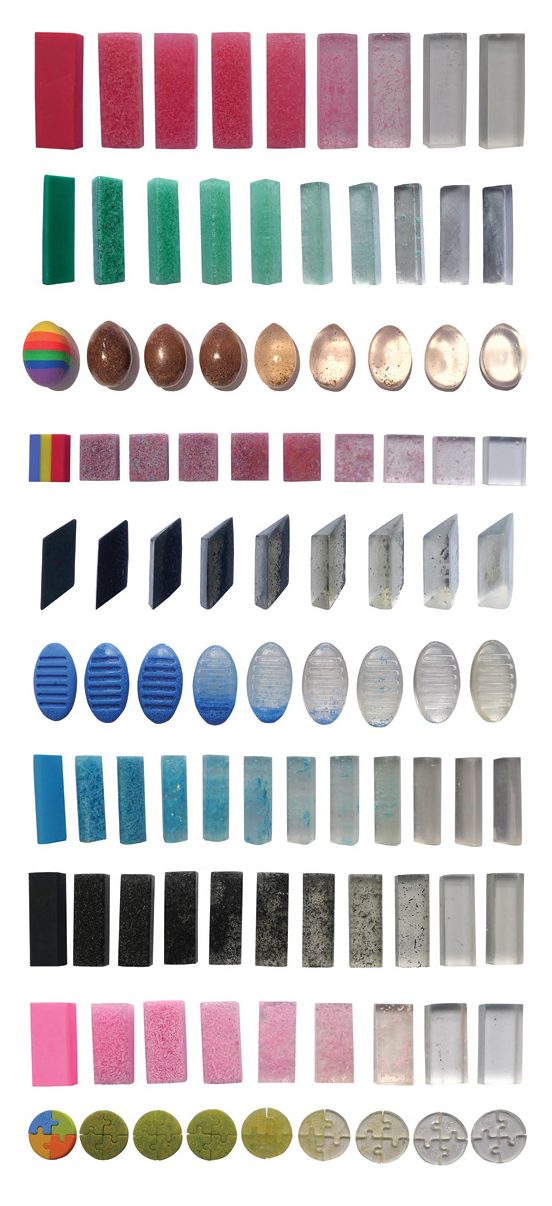
Nilo Ilarde
Erased, Eraser 1–13
2015
Eraser, eraser dust, resin
Variable dimensions
Photo: MO_Space and Nilo Ilarde
The Event, Trace and Evidence
I tell of two studies that characterise well this gap between an event and evidence. In 1993, Chris Marker made a film The Last Bolshevik (Le Tombeau d’Alexandre) in which he explores the great Soviet filmmaker Aleksandr Medvedkin. In it he shows a famous photograph of the storming of the winter palace at the time of the Bolshevik-led revolution in 1917. However, Marker reveals that, in fact, the photograph was that of a 1920 theatrical celebration of the event in 1917.5 Bearing an uncanny resemblance to the original event, it had come to serve as a document and hence an archival record of the event. To the degree to which the photograph in fact documented a theatrical re-enactment not only stood as testament to the veracity of the re-enactment but, more broadly, to the power of the photographic image to assume the authority of the originating referent. This instance provides a key to Chris Marker’s sceptical view towards the photographic document and its tacit claim of authority as regards to the real. Moreover, once this is claim had been disrupted, the character and claims of the archive as proof of an original event began to be contested.
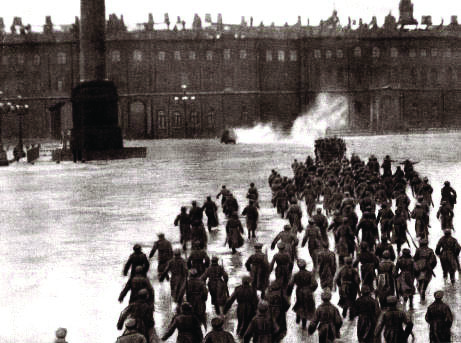
The storming of the winter palace 1917
Staged re-enactment in 1920
Public Domain, https://commons.wikimedia.org/w/index.php?curid=1030309
The second study was by David King who explored in his book The Commissar Vanishes, what had taken place under Stalin in the Soviet Union. King found photographic records documenting public events and leaders of the revolution. Often the same event had been photographed twice or more. But, in comparing photographs, King found systematic changes in which individuals had been erased from the photograph. He shows for example group photographs of Lenin with Trotsky or Lev Kamenev (a leading member of the Bolsheviks), and then those photographs again in which Trotsky and Kamenev have been erased, as if they were never there! The Cambridge English dictionary has an apt characterisation of this technique of ‘airbrushing’: “It is almost as if revolutionary leaders have been airbrushed out of history.”6 This method was a way of re-writing history so as to erase and bury what had taken place as an event or of people who were no longer in favour.
In her 1967 essay, Hannah Arendt issued a warning:
The chances of factual truth surviving the onslaught of power are very slim indeed; it is always in danger of being manoeuvred out of the world not only for a time but, potentially, forever. Facts and events are infinitely more fragile things than axioms, discoveries, theories—even the most wildly speculative ones—produced by the human mind; they occur in the field of the ever-changing affairs of men, in whose flux there is nothing more permanent than the admittedly relative permanence of the human mind’s structure. Once they are lost, no rational effort will ever bring them back.7
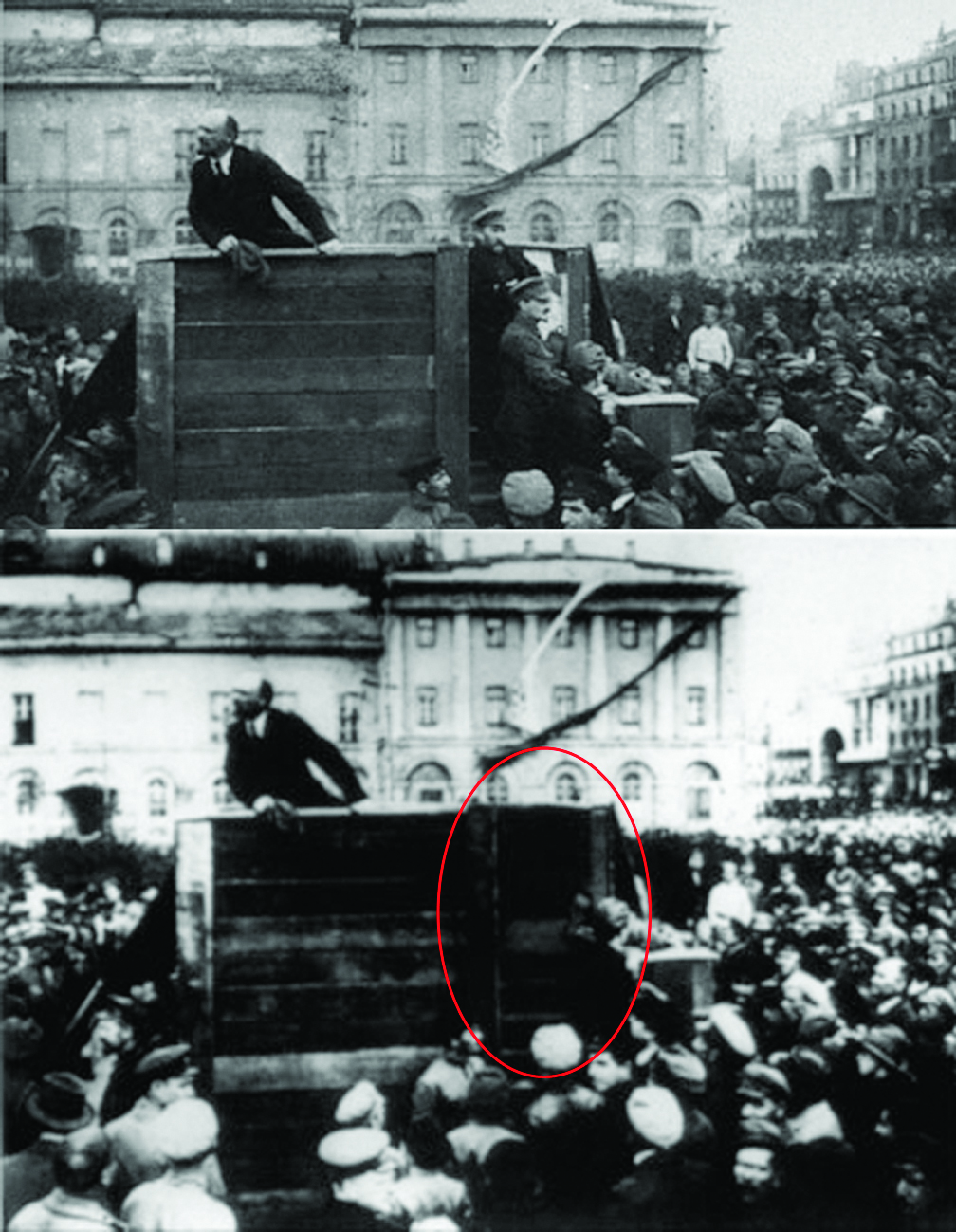
TOP
Vladimir Lenin speaking in Moscow to Red Army soldiers
departing for the Polish front, in 1920. Leon Trotsky and
Lev Borisovich Kamenev, behind, are on the steps to the right.
Collection of Tate. Photo: G. P. Goldstein.
BOTTOM
Leon Trotsky and Lev Borisovich Kamenev have been
airbrushed out of an image of the same scene.
Collection of Tate. Photo: G. P. Goldstein.
Arendt’s reflections are apposite to the instrumental way that photography or film and video began to be used in the documentation of events. The mediums had been used as material evidence that allowed a viewer to visually know and reconstruct or recall an event. However, to view the event in such terms is to suggest that a material memory or trace to do with the past survives in the present, a materiality that can be identified. Is the trace therefore something residual: a remainder that survives, like a fragment? In allowing us to look back, the trace offers a connection to the world insofar as it operates as a memorial form tied to the past but, forever threatened by forgetfulness and erasure. Or, is the trace alternatively, something less, insofar as its appearance is not a matter of survival but, rather more like the hollowed-out imprint of an impression: a past that has never been present? This would be a past which no memory, no-‘thing’ could resurrect, capture, represent as present. This paradox then is that the trace becomes a past that has never been present, that is always under the sign—if it can be called a sign—of erasure. And, yet, if the trace becomes something both less and more than the originating referent, does this not, in some manner, split the figure of the trace.
How do we delimit the trace except by what is inscribed, in effect, through the disappearance of what we may infer produced it? Appearance is constituted by the erasure of such marks. It is not a sign insofar as it is purely indicative or stands in an empirical relation to an event or something once present. There is nothing residual here—no fragments, ruins, marks or evidence—so it does not seek (by way of pathos or nostalgia) an originating moment. In these terms, the past cannot be made present, brought back, resurrected or redeemed. It is past.
The space between the event and evidence of it having occurred, is problematic insofar as a trace can never be the original to which it refers. Rather, the trace is founded within a movement of erasure: an erasure because it is only a shadow or imprint of the impression made. It is constituted through erasure and division. Jacques Derrida refers to the trace as a “still-living mark on the substrate, a surface, a place of origin.”8 Taken in this way the trace no longer finds itself imprisoned within the confines of presence and absence, but is instead conditioned by its movement of repetition and difference. We might say that the work appears to gather its meaning by way of an estranged relation to itself. By neither repeating nor returning us to the place of origin, the index opens up an interval that is discontinuous with what has gone before. This is not a work of nostalgia, a re/turning as if symbolising an experience of loss and desire to recapture the past or an identity of self through an origin. Rather, it marks a space between impression and imprint, neither present nor absent insofar as there is no plenitude either given or referred to as elsewhere. There is here the sense of an aporia, a hollowing out, an encounter with the outside of the self, its exteriority. The encounter with the outside of the self is the self’s origin.
“I mark(s) first of all a division in what will have been able to appear in the beginning.” —Jacques Derrida9
To think the trace in these two ways, is to pursue its trail either back or forward, to see it alternatively, as either attachment or detachment, re-presentation or erasure, proximity or distance, a return or a leave-taking. It is at once bound by the past and open to the future, because it remains to be seen—can only be seen and therefore understood—after the fact. Falling on either side of this divide, the trace either informs and shapes the future by virtue of its ties to the past and yet, bound by the future, always coming after, opening onto a horizon that exceeds its referent. Such a trace would tear itself apart, dividing itself in order to break all attachment. We are now at the place that exceeds the horizon from where we started, a promise of elsewhere, an emancipation. Perhaps, this is what the editor of ISSUE meant when he referred to erase’s power to “unleash(ing) ways of imagining the world and bringing to the forefront ideas deeply buried in the human conscience.”10
Tracing the Event
Let me pick up again my comments about the Event and its definition in the light of the split condition of the trace. That is, to take as a starting point, the incommensurability between ‘eventhood’ and the meaning or significance of the event. This incommensurability between origin and repetition in the artwork need not lead us to declare, or even commiserate about, the impossibility of telling history. Rather, in locating the anachronism between the temporality of the event and that of our writing, we may say there is a form of excess in both the event and its re-presentation. This recognition of the incommensurate – of what has been called a diachronic temporality—enables us to recognise the other through an exposure to the wound within history: the trauma that both disturbs and is revealed through narration, exceeding restitution and forgetting. The artist or historian is exposed, and in turn exposes the reader, to the trace as an encounter between the impression and imprint, and to the formation of a historical and textual unconscious that haunts the present.
The historian Carlo Ginzburg, in his essay, Clues: Roots of an Evidential Paradigm, observed that art history belongs to a family of conjectural sciences that emerged in the late 19th century. He explored how the discipline of art history was like forensic medicine (criminology), philology or psychoanalysis, originally structured around a reading of material traces, such as tracks and fingerprints, which provided evidence of the originating event, scene or person involved. Traces, in other words, were viewed as bearing us or, at least, providing a means of leading us back to the source. Experts could map and differentiate the epistemological evidence that could establish the originating event or author of the case.
While this constitutes a story of origins in itself, it led to the emergence of a discipline (art history) that looked upon art as the shimmering ‘afterlife’ or nachleben of the past. Seen within the present, art represents the survival and transmission of the past, carrying with it traces of another place, time and culture. Art history became a trail leading us back to that inaugural moment in which the object or event comes into existence, itself a form of trace constituted in its separation from the artist and from the culture in which it originates. This is what gives the writings of art historians, such as Aby Warburg or Michael Baxandall, an almost elegiac quality in their prose. It is as if they discover, in the process of their writing, that the very language they use as a means to preserve the object and bring its past to life, is implicated in the loss of that object and its original meaning.
The trace would be like a fleeting shadow doomed by its fatal attachment to something that is irretrievably lost and therefore the subject of mourning or melancholy. The art historian’s practice becomes a redemptive project. They immerse themselves in the archive, seeking to revive the voices and the gazes that stare back at them. Such an approach is reminiscent of the work of the great 19th-century French historian Jules Michelet and his desire to ‘exhume’ the figures of the past for a ‘second life.’ Entering the ‘catacombs’ of manuscripts he noted: “I am not slow to discern in the midst of the apparent silence of the galleries, a movement and murmur which were not those of death.”11
I turn to Sigmund Freud’s Delusions and Dreams in Jensen’s ‘Gradiva’ (1961), an essay that concerns Wilhelm Jensen’s novel Gradiva: A Pompeiian Fancy, written in 1903, about a young archaeologist, Norbert Hanold. Jensen describes Hanold’s consuming passion for a relief of the figure of Gradiva in a museum of antiquities in Rome. While Gradiva serves as an emblem of archaeology, she is equally representative of art history’s relation to the trace. As a consequence, he journeys to the ruined city of Pompeii in search of a bas-relief of the figure at its original site. The presence of Gradiva, Hanold believes, is to be found in the imprint of her footsteps in the ashes of Pompeii. In this way, he hopes to be able to find her traces, and dreams of bringing Gradiva back to life, overcoming the discipline of archaeology, which he views as something conditioned by following the footsteps of the dead.
The trace as it remains, however, is only a trace, everything and nothing, the discovery of which provides no rest for Hanold. His desire for Gradiva does not abate. Her traces seem rather to induce an even greater obsession and Hanold becomes haunted and driven to insanity. For Freud, Jensen’s story concerns the idea of the past being, in some way, still present, as though locked up inside the present.
Freud wants the stones to speak, as if behind the trace there is a footstep to be found. No less than Hanold, Freud wants to recover a full presence, to bring the repressed into the light. Both are driven by a desire to trace the archive back to its inaugural moment just prior to the separation of origin and representation: an irreplaceable and unique moment of truth before its repetition and loss of originality. In this manner, the stories told by Freud and Jensen serve as parables about archaeology and psychoanalysis, where both are defined by the search for a repository that would constitute an ‘origin’, but an origin that can only be traced by the traces themselves.
For Freud, archaeology could provide a way of thinking through the very concept of memory and the unconscious, and art—like writing—like the archive—represented a prosthetic aid to memory. Later, Freud wrote in his essay A Note upon the Mystic Writing Pad (1924–25) that “all forms of auxiliary apparatus which we have invented for the improvement or intensification of our sensory functions are built on the same model as the sense organs themselves or portions of them . . .”12 To illustrate this, Freud used the bloc magique, a popular children’s toy made of a wax surface covered by a sheet of cellophane. When marked, an impression is left on the surface, and when the cellophane is lifted the impression disappears, although it leaves an invisible trace in the wax itself. In his way the toy provides both “an ever-ready receptive surface and permanent traces of the notes that have been made upon it.”13 These traces are not overtly present but, nonetheless, flicker beneath our consciousness.
In his book on Freud and the archive, Jacques Derrida suggested that Freud too was caught up in this pursuit of an originary moment.14 Derrida’s purpose in revisiting this story is to show the way repression and the archive are intertwined. Repression is, he argues, a form of archivation. Traces come after the fact and this evidence is a trace of the event, serving as a document and material for the making of an archive. In this context, traces were not simply signs and clues, but the residual remains, the material evidence and stuff of history.
Moreover, as Derrida argues, the archive, like the trace, is itself divided or disturbed by this repression that lies at its constitutive heart. For Derrida, we never can or do stand before the arche or origin, but are delivered over to the trace, assigned to one archive or another, to one inside another, en abime. He suggests that Hanold recognises that the trace exceeds both its origins and the archive. It is the trace of Gradiva that has taken him to Pompeii, seeking the uniqueness of her impression, of her traces. As Freud writes: “traces in the literal sense; for with her peculiar gait she must have left behind an imprint of her toes in the ashes distinct form all the rest.”15 It is a recognition that the uniqueness is to be found there in the imprint, in this moment of division, its repetition as a trace that comes after and therefore effaces what came before: Gradiva.
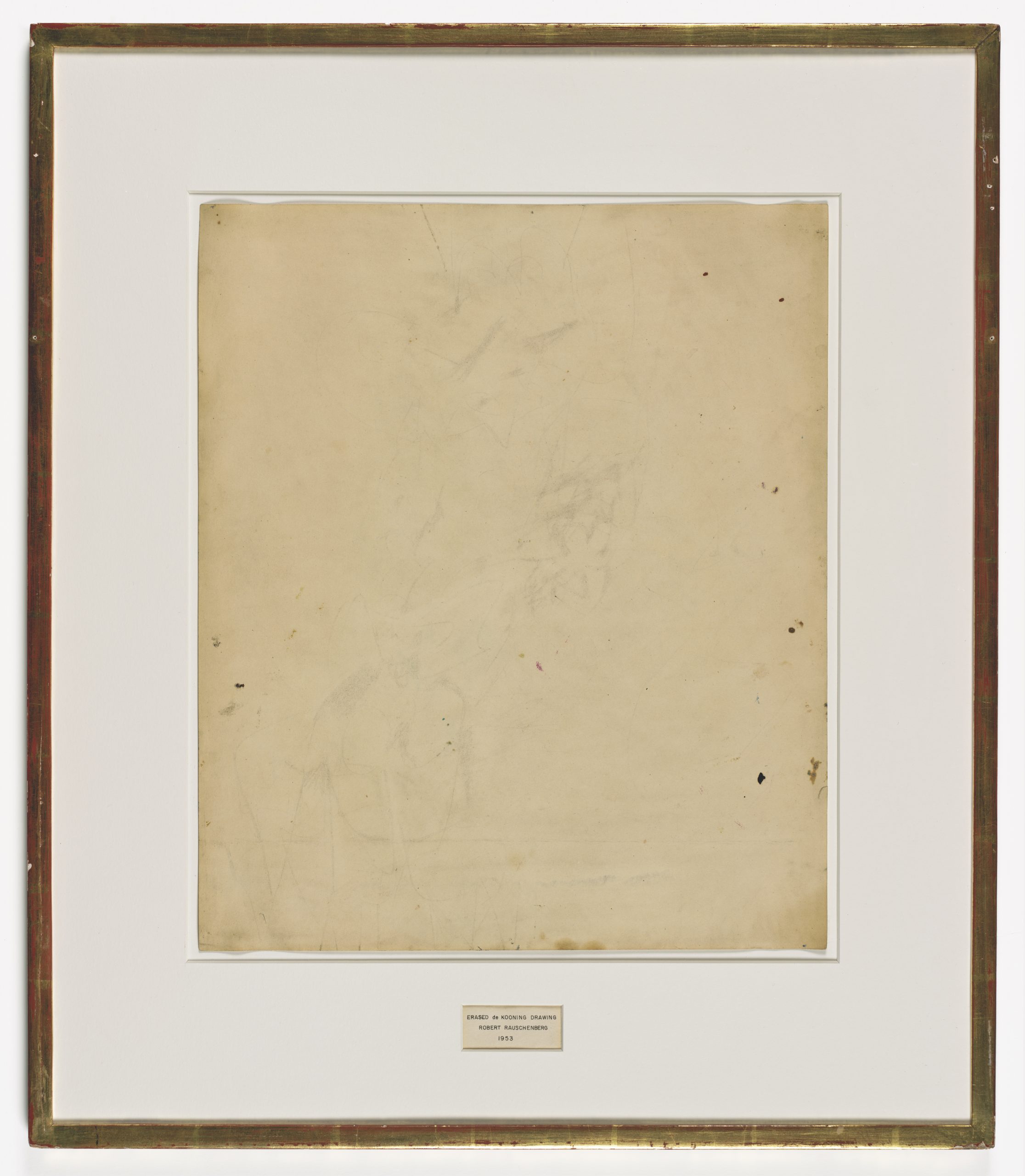
Robert Rauschenberg
Erased de Kooning Drawing
1953
Traces of drawing media on paper
with gilded frame
64.1cm × 55.2 cm ×1.3 cm
Collection of SFMOMA
Purchase through a gift of Phyllis C. Wattis
© Robert Rauschenberg Foundation
Licensed by VAGA at Artists Rights Society
(ARS), NY. Photo: Ben Blackwell
Erasure as a Method of Making
Some four years ago, I organised an exhibition entitled Erasure: From Conceptualism to Abstraction for the Osage Art Foundation in Hong Kong. I began my catalogue essay with a brief discussion of Robert Rauschenberg’s erasure of a drawing by de Kooning. Rauschenberg had bought a recent drawing from his friend de Kooning dated 1951, erased the original and then exhibited it as Erased de Kooning Drawing. Jasper Johns wrote at the time that Rauschenberg had spent a month erasing the work and after the use of 40 erasers, had left “a surface startlingly alive, active, palimpsestic.”16 It was as Johns noted, an “additive subtraction.”17
The exhibition Erasure ranged across a broad reading of erasure as central to an artistic process of making art. It included some 22 artists from across Asia, including Maria Taniguchi and Nilo Ilarde who, as noted earlier here, used the method of erasure as a central component in some of their work.18
Apart from Studio Visit (2012) discussed earlier, other works by Taniguchi also explore erasure and the trace. This is found in the series Untitled, a continuation of her Brick paintings (2008), which is composed of seemingly limitless repetitions of acrylic and graphite lines and hues that create rows of grey brick or box-like forms over the surface of the canvas. There are internal shifts, interruptions to the degree that Joselina Cruz, in Kaleidoscope, characterises as grid-like forms, a skin and method of painting, an ‘archaeology.’ In so doing, viewing the work reveals signs or clues of minute differentiation. As Kathleen Ditzig suggests, Taniguchi generates “ways to see through the surface.”19 Any mark leaves an irreversible trace. Crossed out, painted over, erased, it nevertheless remains, each time different. As with her paintings, the focus is on the space of subtraction. This allows the viewer to witness the process, a process that entails the normal process of alterations and revisions but is etched and therefore resolutely documented.
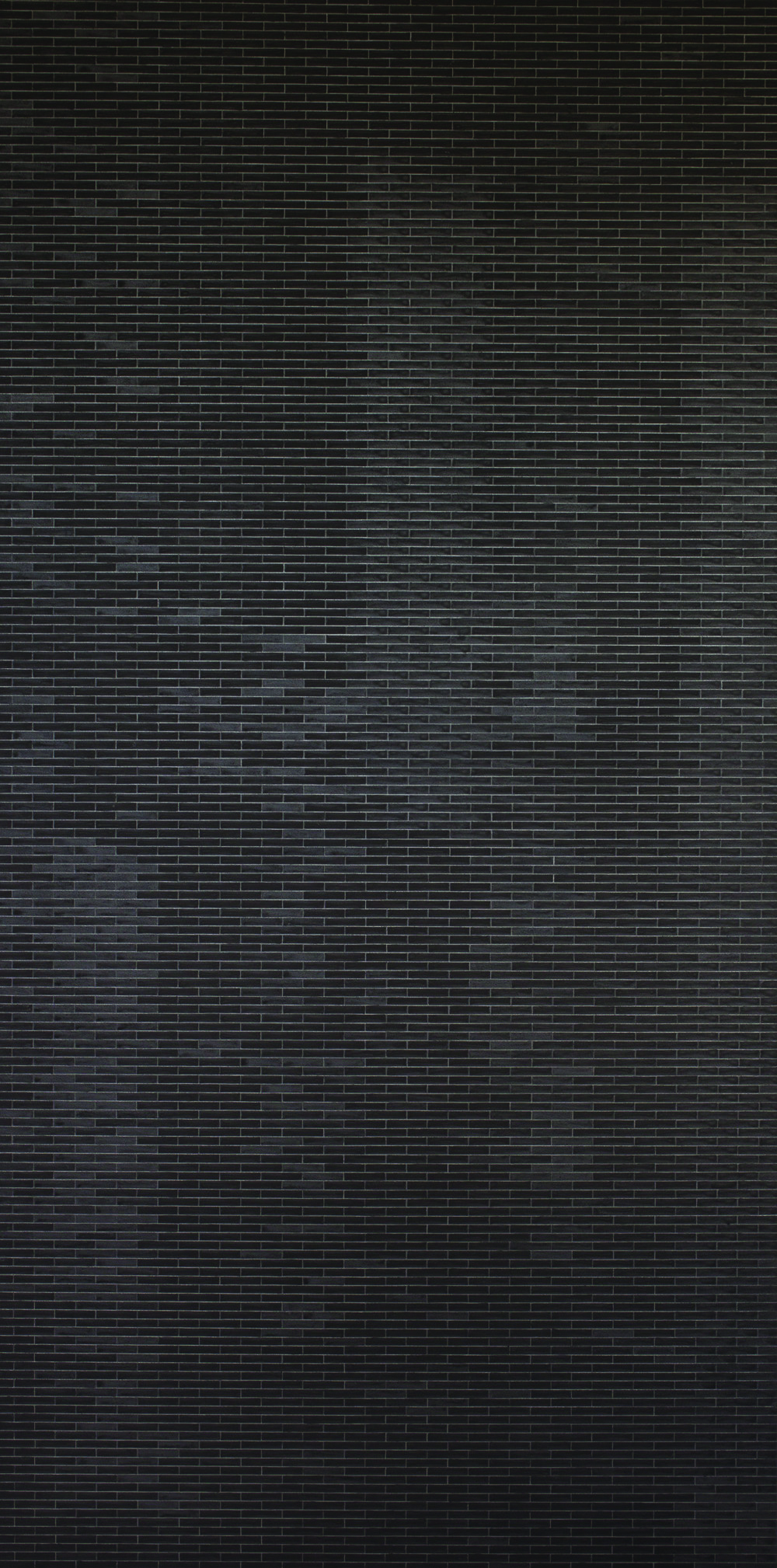
Maria Taniguchi
Untitled
2015
Acrylic on canvas
228.6 x 114.3 cm
Photo: Silverlens and the Artist
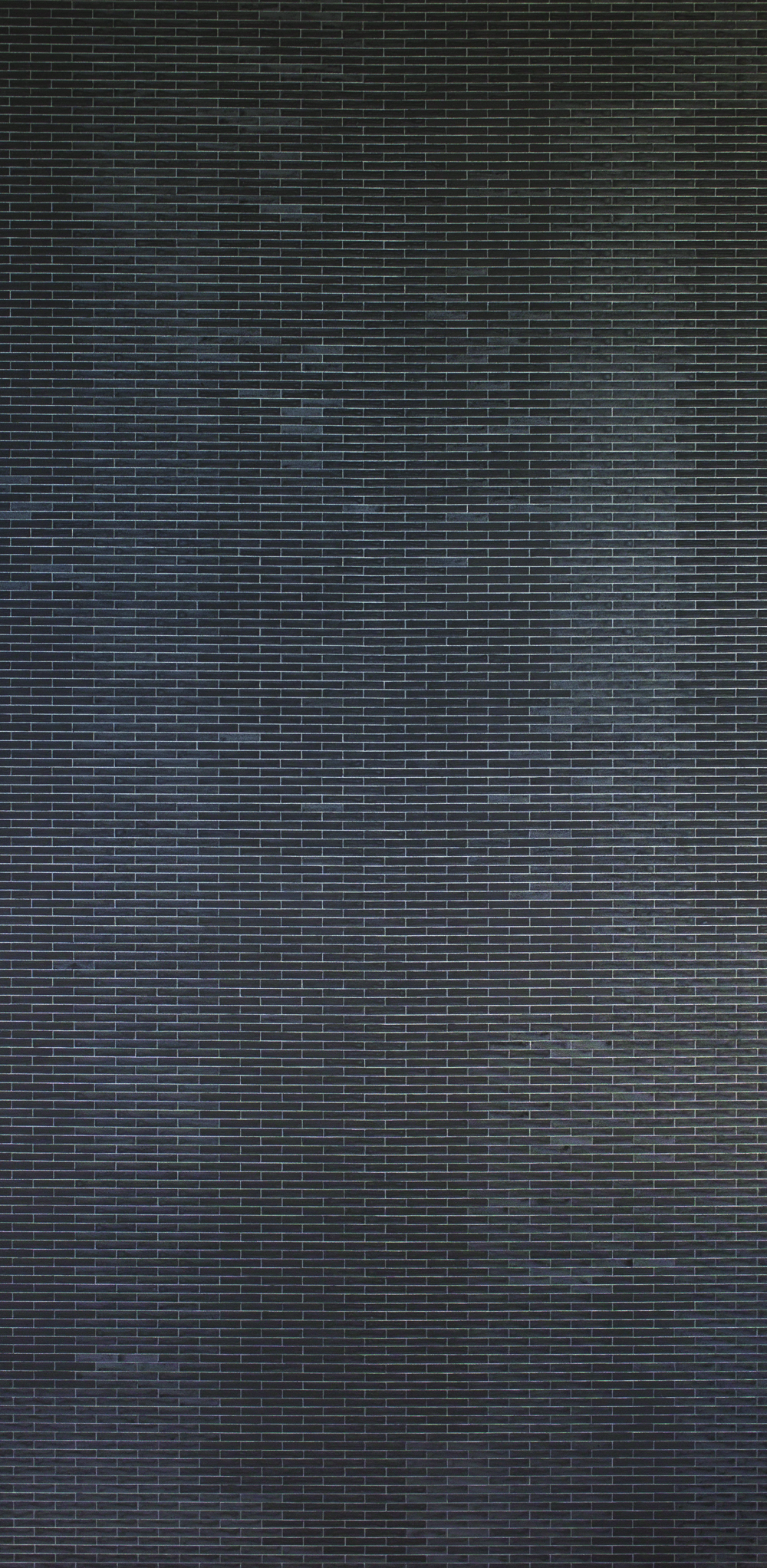
Maria Taniguchi
Untitled
2015
Acrylic on canvas
228.6 x 114.3 cm
Photo: Silverlens and the Artist

Maria Taniguchi
Untitled
2016
Acrylic on canvas
228.6 x 114.3 cm
Photo: Silverlens and the Artist
Milenko Prvački’s work also engages more broadly with the subject and method of erasure.20 Objects appear in his paintings as incomplete, fragments at best, or an echo of a form elsewhere, losing their immediate meaning or particularity. More often than not, Prvački’s work suggests a movement trapped by the lingering shadows and traces of the past.
The biography is pivotal to an understanding of Prvački’s practice, especially the idea of homeland (Yugoslavia/Serbia) with its recent social history—the Balkan wars—and the cultural context of Prvački’s education and milieu.21 The very idea of logic, if this is even an accurate term of description, that drives the work of Prvački harks back to a former life of his and to a country and world he poignantly remarks “does not exist anymore.” There is no appeal that can be secure whether through a false sense of past unity or the melancholy of nostalgia. This would be a space of lack, of absence has opened, if not cleared, a space for an imaginative re-encounter rather than return to issues concerning his homeland.
In his series Covered Up (2012), there is an ambiguity latent within its colloquial use, suggesting the idea of covering an object or something not to be seen, hidden from view, for instance in the case of a crime scene. Alternatively, the term can refer to painting itself and more specifically, to the process of painting over that which has already been painted. This is a form of landscape that if examined carefully reveals the construction work that has gone on, the various buildings once standing, the now vacant lots and scattered objects, materials and matter. This is the debris of history left behind, the remains of history’s destruction, the remembrance of things past now. In various series, Prvački uses the idea of the visual dictionary, as analogous to not only learning a new language, (as he did with English when he arrived in Singapore) but also to recovering and capturing a visual memory of his past.22
What is critical here is the subject of memory and the process of remembering that are intricately interconnected but also distinct. What happened and what we call memory are never the same. To lay emphasis on the process of remembering is critical precisely because it does not assume any fixed position. Rather, remembering emphasises a process of the now as much as, if not more, than then. The process of erasure will always leave a trace.


